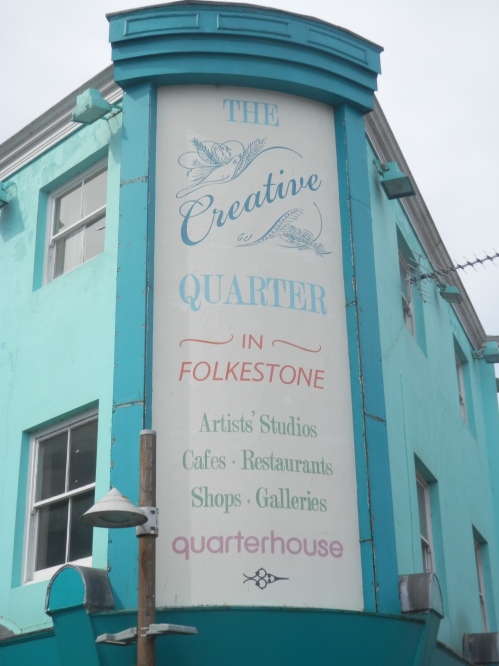I am proposing to run twice, possibly thrice, weekly walking tours of Folkestone next summer (May to September 2017).
There are many practical considerations, including health and safety, marketing and potential licensing, that need to be addressed in the opening weeks of the New Year, but the crucial issue is the integrity of the tour itinerary itself.
Below are my initial thoughts on what route to take, and the issues to highlight at each stop and during the walk itself.
Currently, I envisage the tour lasting no longer than two hours.
These are still early thoughts and are subject to change. Being still a relative newbie, there is a distinct possibility that I may have missed something. This is where long term residents of Folkestone and others who have, like myself, come to love the town, can help me in fine tuning the details. I would be extremely grateful for their input and support.
I intend to finalise this by the end of February, allowing two months to work up the detailed commentary and supporting material.
I am extremely grateful for your assistance in this. Don’t feel you need to be gentle with me!

Start: By the Earth Peace sign in front of The Grand Hotel on The Leas
Stop 1: The Grand Hotel
a. outline of tour – duration – route – stops – toilets – refreshments – approach to questions
b. history of The Leas and Folkestone as a holiday destination – English & French coast highlights
c. history of The Grand, including rivalry with The Metropole & links to royalty
d. introduction to Folkestone Triennial & Folkestone Artworks, specifically Earth Peace (Yoko Ono)
Walk 1: Along The Leas, passing the View Hotel, Ruth Ewan (clock) and Mark Ballinger’s (Folk Stones) artworks & talking benches
————————————————————————–
Stop 2: Leas Cliff Hall
a. history – construction – programme
b. William Harvey statue
Walk 2: Along The Leas passing the Leas Pavilion Theatre and the Leas Lift
————————————————————————–
Stop 3: Step Short Arch
a. Folkestone’s role in war
b. construction
c. War Memorial
d. poppies
Walk 3: Down the Road of Remembrance

Stop 4: Harbour Station / Harbour Arm entrance
a. role of trains bringing soldiers/holidaymakers
b. history of ferry / hovercraft services
c. Hamish Fulton’s metal sign
d. Grand Burstin Hotel
e. regeneration plans
Walk 4: Along the Harbour Arm, taking in views of the Harbour
————————————————————————–
Stop 5: Lighthouse on Harbour Arm
a. history
b. Weather is a Third to Place and Time artwork
c. Champagne Bar
Walk 5: Back along Harbour Arm and towards Harbour
————————————————————————–
Stop 6: Harbour
a. fish market
b. history of fishing c/f activity today
c. seafood stalls
d. Rocksalt
Walk 6: Along The Stade to Sunny Sands
————————————————————————–
Stop 7: Sunny Sands
a. beach & Coronation Parade
b. views to France, Harbour Arm, East Cliff, Dover Strait, the Warren & Samphire Hoe
c. Folkestone Mermaid (Cornelia Parker)
Walk 7: Back along The Stade and across to Creative Quarter entrance
Stop 8: The Old High Street
a. history
b. role of Creative Quarter
c. Quarterhouse
Walk 8: Up the Old High Street and onto The Bayle, highlighting galleries, restaurants and coffee shops

Stop 9: The Bayle
a. history
b. Parade Steps
c. Shangri-La
d. British Lion
e. pond – child’s mitten (Tracey Emin)
Walk 9: Around The Bayle into Church Street
————————————————————————–
Stop 10: Church of St Mary and St Eanswythe
a. history of christianity in Folkestone
b. life & sainthood of St Eanswythe
Walk 10: Through churchyard and along The Leas towards the Leas Lift
————————————————————————–
Stop 11: Leas Lift
a. history – construction – importance
b. take lift down to Marine Parade
Walk 11: Along Marine Parade to entrance of Lower Leas Coastal Park
Stop 12: Lower Leas Coastal Park
a. background, construction & awards
b. Fun Zone
c. Amphitheatre
d. Adam Chodzko’s Pyramid
Walk 12: Through Lower Leas Coastal Park to beginning of Zigzag Path

Stop 13: Zigzag Path
a. history
Walk 13: Up the Zigzag Path and along The Leas to The Grand Hotel
————————————————————————–
Stop 14: The Grand Hotel
Finish by the Earth Peace sign in front of The Grand Hotel on The Leas
————————————————————————–





















